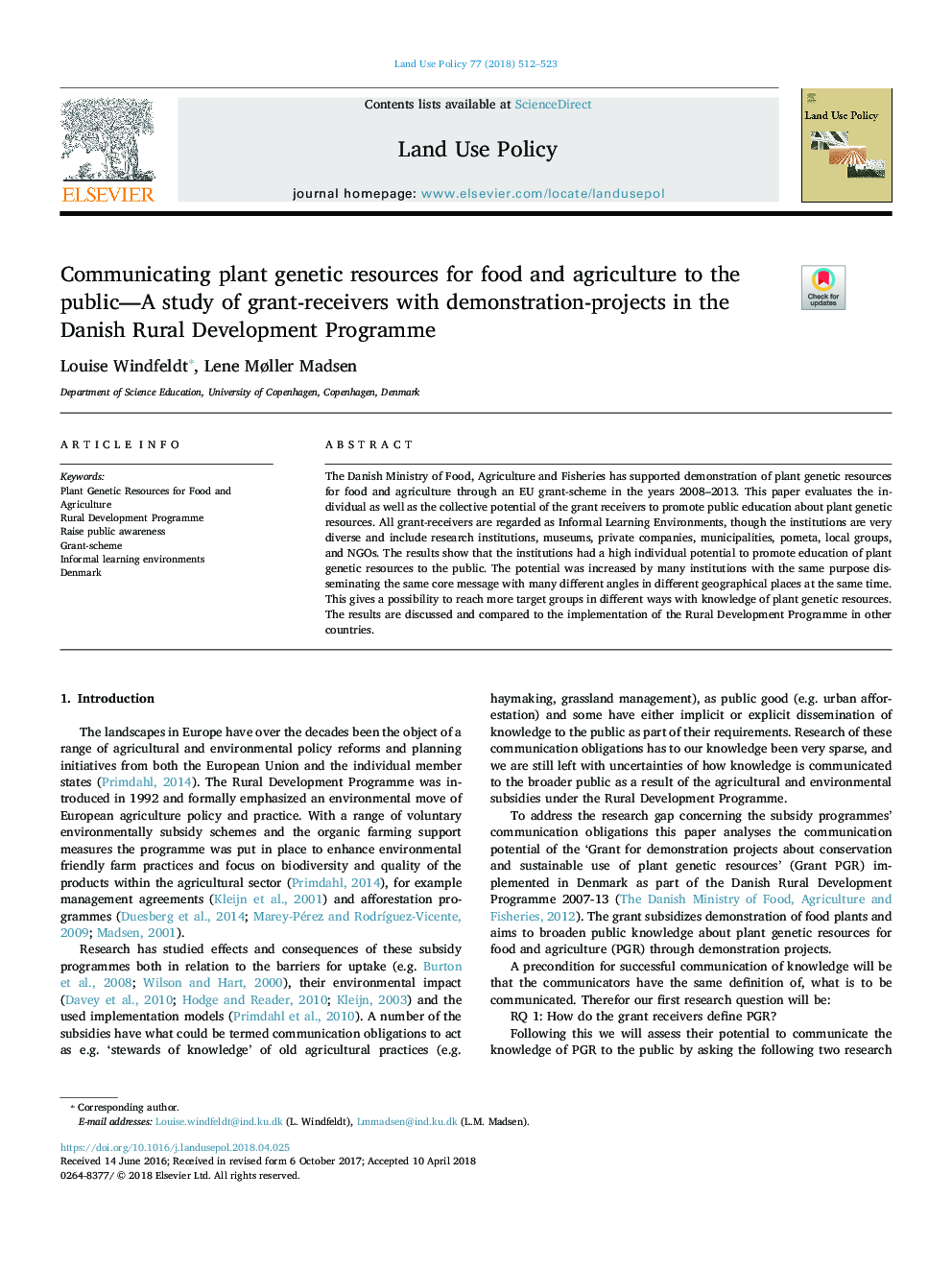| کد مقاله | کد نشریه | سال انتشار | مقاله انگلیسی | نسخه تمام متن |
|---|---|---|---|---|
| 6546177 | 1421806 | 2018 | 12 صفحه PDF | دانلود رایگان |
عنوان انگلیسی مقاله ISI
Communicating plant genetic resources for food and agriculture to the public-A study of grant-receivers with demonstration-projects in the Danish Rural Development Programme
ترجمه فارسی عنوان
برقراری ارتباط منابع ژنتیکی گیاهی برای غذا و کشاورزی به مردم - مطالعه مجاز گیرندگان با پروژه های تظاهرات در برنامه توسعه روستایی دانمارک
دانلود مقاله + سفارش ترجمه
دانلود مقاله ISI انگلیسی
رایگان برای ایرانیان
کلمات کلیدی
منابع ژنتیکی گیاهی برای مواد غذایی و کشاورزی، برنامه توسعه روستایی، بالا بردن آگاهی عمومی، گرانت طرح، محیط یادگیری غیر رسمی، دانمارک،
ترجمه چکیده
وزارت غذا، کشاورزی و شیلات دانمارک از تظاهرات منابع ژنتیکی گیاه برای غذا و کشاورزی از طریق یک طرح کمک هزینه اتحادیه اروپا در سال های 2008-2013 حمایت کرده است. این مقاله فرد و همچنین پتانسیل جمعی گیرندگان کمک مالی برای ارتقای آموزش عمومی در مورد منابع ژنتیکی گیاه را ارزیابی می کند. همه گیرنده ها به عنوان محیط یادگیری غیر رسمی در نظر گرفته می شوند، هر چند موسسات بسیار متنوع هستند و شامل موسسات تحقیقاتی، موزه ها، شرکت های خصوصی، شهرداری ها، پومتو، گروه های محلی و سازمان های غیر دولتی می باشند. نتایج نشان می دهد که مؤسسات بالقوه انسانی بالایی دارند تا آموزش و پرورش منابع ژنتیکی گیاهان را به عموم ارتقاء دهند. این پتانسیل توسط بسیاری از موسسات با همان هدف گسترش پیام همان هسته با زوایای مختلف در نقاط مختلف جغرافیایی در همان زمان افزایش یافته است. این به دانشمندان منابع ژنتیکی گیاهی اجازه می دهد تا به گروه های هدف بیشتری دست پیدا کنند. نتایج به دست آمده در مقایسه با اجرای برنامه توسعه روستایی در سایر کشورها مورد بحث و بررسی قرار گرفته است.
موضوعات مرتبط
علوم زیستی و بیوفناوری
علوم کشاورزی و بیولوژیک
جنگلداری
چکیده انگلیسی
The Danish Ministry of Food, Agriculture and Fisheries has supported demonstration of plant genetic resources for food and agriculture through an EU grant-scheme in the years 2008-2013. This paper evaluates the individual as well as the collective potential of the grant receivers to promote public education about plant genetic resources. All grant-receivers are regarded as Informal Learning Environments, though the institutions are very diverse and include research institutions, museums, private companies, municipalities, pometa, local groups, and NGOs. The results show that the institutions had a high individual potential to promote education of plant genetic resources to the public. The potential was increased by many institutions with the same purpose disseminating the same core message with many different angles in different geographical places at the same time. This gives a possibility to reach more target groups in different ways with knowledge of plant genetic resources. The results are discussed and compared to the implementation of the Rural Development Programme in other countries.
ناشر
Database: Elsevier - ScienceDirect (ساینس دایرکت)
Journal: Land Use Policy - Volume 77, September 2018, Pages 512-523
Journal: Land Use Policy - Volume 77, September 2018, Pages 512-523
نویسندگان
Louise Windfeldt, Lene Møller Madsen,
